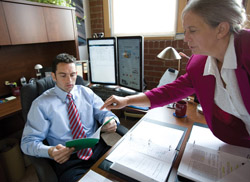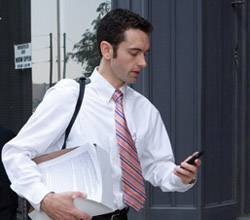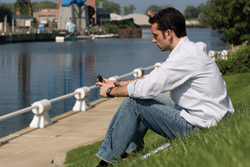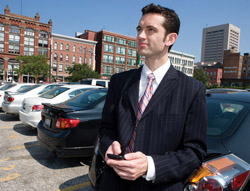The Long Shot

David Mills runs his practice out of his home office with the help of one part-time paralegal -- his mother, Elisabeth. (Photos by Wayne Slezak)
When David Eduard Mills walks to the lectern on Nov. 1, he will be unlike any other advocate arguing before the Supreme Court of the United States this year.
Most are veterans of the Supreme Court Bar. They have teams of partners, associates and staffers supporting their efforts. Their large law firms have deep-pocketed clients or government agencies providing the much-needed resources required to take a case to the nation’s highest court.
By contrast, Mills is a 33-year-old solo practitioner who’s appealing an unpublished lower court decision. His only previous appearance before the Supreme Court was as a visitor watching oral arguments a few years ago. His law office is located in a spare bedroom in his apartment. He has no staff, except for his part-time paralegal, Elisabeth, who goes by another title: Mom. His client, for payment, offered him the title of her Jeep and made him an afghan.
But the Cleveland counselor’s life and law practice are about to change dramatically due to his oral argument in Ortiz v. Jordan. His days of surviving on court-appointed cases are soon to end, as federal appellate lawyers predict he will inevitably be bombarded by paying clients. And, in an ironic twist, Mills is likely to become a national speaker at bar associations and law schools across the country on alternative law practices and quality of life.
“Thirty minutes after certiorari was granted, the Supreme Court writer for the Associated Press was calling me for comments,” he says. “I’m getting calls to speak at law conferences. There is probably no better way to advertise than to argue a case at the Supreme Court. Yeah, this changes everything. Maybe not right away, but certainly over time.”
However, Mills cannot be grouped with many other new solo practitioners who found themselves unable to score work at bigger firms. He gave up a lucrative practice at a large international firm two years ago to go solo as a federal appellate lawyer. He had only $20,000 in the bank, no paying clients and no guaranteed sources of income. Friends and fellow lawyers told him he was crazy, especially in these tough economic times.
“I wanted to create my own reality,” says Mills. “Now, don’t get me wrong—there have been a lot of tough times the past two years. I had to borrow $5,000 from my little brother [to pay bills], and I have eaten a lot of peanut butter and jelly sandwiches.”
A 2002 graduate of the University of Michigan Law School, Mills spent almost four years in the litigation practice group at Jones Day in Cleveland, where former firm colleagues say he was the kind of lawyer who was on the fast track to partnership. In 2006, he left to clerk for Judge R. Guy Cole Jr. of the 6th U.S. Circuit Court of Appeals at Cincinnati. The next year, he clerked for U.S. District Judge Louis F. Oberdorfer of Washington, D.C., who was sitting by designation in a series of appellate cases in the 1st, 2nd, 6th and 9th Circuits.
ONE QUESTION

Mills gave up a lucrative practice at a large international firm to go solo as a federal appellate lawyer.
In the spring of 2008, as he was in negotiations to return to Jones Day, Mills started mulling a new venture. He bought a handful of books on starting a solo federal appellate law practice and began seeking advice from one of the most well-known and successful lawyers to leave a big firm to start a solo Supreme Court practice: Tom Goldstein of Washington, D.C., also a former Jones Day associate.
Goldstein, in response to Mills’ inquiry about starting his practice, responded with one question: “Who do you expect to send you business?”
“Every year, I get a number of lawyers who call me saying they are going to do it on their own,” says Goldstein, now co-head of the Supreme Court practice at Akin Gump Strauss Hauer & Feld. “Some of them do it for a year and find out it isn’t for them. Others realize that it’s just financially too difficult and rejoin a big firm or go to work for the government.
“It’s much harder now than when I did it because there are so many more lawyers competing for the small pool of cases,” he says. “When I started in 1998, there were only six Supreme Court practices. Now there are 30.”
But Mills was determined. He quickly learned he was doing more than opening a law practice: He was starting a business, and that meant making important business decisions. For example, he spent days trying to figure out what to name his new firm. Mills Googled several possibilities, just to see what would pop up. The bar association warned him off some names containing “federal appeals.” He settled on the Mills Law Office for his firm name but made his Web address millsfederalappeals.com, both of which passed state bar scrutiny.
Mills spent a few days checking city ordinances and his lease to make sure he could operate a law firm out of his apartment, as well as confirming that his place is accessible to those with disabilities. He had no idea about malpractice or health insurance. He needed office furniture. And he had to figure out what to charge clients—if any paying ones ever finally called upon him. He settled on $275 an hour, which is about half of what his hourly rate would have been at Jones Day.
Finally, Mills wanted to make his official law practice opening announcement in a dignified way by sending a letter to key partners and judges around the region.
“I knew I needed really good stationery to send out notice of my firm opening, so I purchased the best paper to make a really good first impression,” he says. “But apparently, the paper was so good that when I folded the letter, the ink from the printer smeared on the paper. Nice first impression, eh?”
Mills immediately signed up to be appointed to represent criminal indigents in the federal appellate system so as to have some revenue coming in. But he failed to realize that payments for such cases usually do not occur for many, many months or even years. And even fixing things himself presents cost-benefit risks.
“When my printer goes down, it costs me a day of work,” he says. “My IT guy really sucks.”
LIVING ON A PRAYER

When he quit the large international firm, Mills had only $20,000 in the bank, no paying clients and no guaranteed income.
“There were some very low points, especially about four months in,” he says. “I truly wondered if I would make it, if I would ever get any paying clients. It was February. It was dark and cold in Cleveland.”
That same month, Mills bumped into a Jones Day partner at a bar association function: “Hi, Mills,” the partner said. “I thought you would be dead by now.”
By spring 2009 things had started to change. He got his first real paying client via Google. The client was a homeowner who lived near the airport who had sued in federal court on a Fifth Amendment takings-clause claim. Her suit had failed at the district court, but her lawyer moved to New Mexico. So she went to Google to find a new lawyer to handle her federal appeal in Cleveland. His thoughtful Internet strategy had paid off.
Then came that Friday in October ’09. It was 12:35 p.m. when Mills learned from another attorney that a woman named Michelle Ortiz was calling all over town trying to find a lawyer to handle her appeal to the U.S. Supreme Court. After Mills quickly looked up Ortiz’s case and found it interesting, he told the other attorney he would be willing to represent her.
In 1996, Ortiz was serving a 12-month sentence for aggravated assault after using a knife to fight off her physically abusive husband. While Ortiz was an inmate in the Ohio correctional system, a guard sexually assaulted her repeatedly. When she reported the incidents, Ortiz was punished and put into solitary confinement, where she was later found ill and vomiting. She filed a federal civil rights lawsuit against the state and the officials at the women’s prison. In 2005 she won a $625,000 jury verdict against the two officials, Paula Jordan and Rebecca Bright.
But in March 2009, the 6th Circuit reversed the verdict, holding that the trial judge erred in not granting summary judgment for the state and the prison officials based on their defense of qualified immunity. The trial judge had granted summary judgment for the state but denied it for the two officials. Lawyers for the prison officials failed to file an interlocutory appeal before trial, which Mills now says should have been done if the state wished to preserve the issue post-trial.
THE OTHERS ARE WRONG
“My trial lawyer told me, ‘Give it up, Michelle, we lost. We’re at the end. It’s over,’ ” Ortiz recalls telling Mills. “I started calling lawyers all over. One lawyer told me he didn’t handle Supreme Court appeals. Another told me that it would cost a lot of money, which I explained I didn’t have. One woman said she couldn’t do it because she did cases for the state. Another lawyer told me the deadline was too tight to file an appeal and that this wasn’t the kind of case the Supreme Court accepted. And one lawyer told me that the Supreme Court didn’t grant extensions. But I knew I was facing a deadline and needed to find someone.”
Mills told Ortiz that the lawyers were wrong, that the Supreme Court does grant extensions. Mills looked at the date of the 6th Circuit opinion. He grabbed the Supreme Court Practice treatise sitting on his desk. He looked at his watch. It was now 1:30. He had four hours to get the petition for an extension prepared and to the post office.
“The first thing I had to do was calm Michelle down,” he says. “I didn’t have the time to explain to Michelle how it would work or to discuss payment, which really worried her. I told her we would deal with fees later.”
Mills sent Ortiz an e-mail at 1:46 p.m. saying that he needed her authorization to file the petition. Two minutes later, she e-mailed back: “I give my full permission for him to proceed with this case in any way he sees fit.”
In his three-page petition for an extension, which had to be filed as three original copies plus attachments, Mills pointed out that the defendant had hired him only four hours earlier. He highlighted 6th Circuit Senior Judge Martha Craig Daughtrey’s dissent, in which she called the decision a “legal travesty,” and he noted a possible conflict in the federal circuits regarding the qualified-immunity question.
“The odds of cert are so, so long,” he says. “But the point of my practice is to give people like Michelle a chance to go to the Supreme Court.”
Ten days later, Mills received a call from the Supreme Court: Justice John Paul Stevens had granted the extension.
A few days later, Ortiz met her lawyer for the first time at his office. He told her that the printing costs for the petition were $2,000, and that the printing costs for the reply brief would be another $3,000.
“He was very young, and I noticed that he lived at his office, which made me a little bit nervous,” Ortiz says. “But he knew the answers to questions that older lawyers didn’t. I knew right away that he was the right lawyer. I remember crying in his office, telling him I didn’t have any money to pay him. I offered him the title to my Jeep. And I knitted him an afghan for his couch because I wanted to give him something I had put a lot of time into, just as he was putting so much time into this case for me.”
Two months later, Mills filed the official petition for writ of certiorari.
His key argument steered far away from the facts of the case. Instead he focused on an extremely narrow procedural issue: whether the prison officials should be allowed to re-raise their qualified-immunity claim in their 6th Circuit challenge after failing to appeal the denial of summary judgment prior to the trial.
The circuits are split on the issue, Mills says, and the question of law remains unanswered.
“I downplayed the facts of this case because I do not want the court, especially Justices Scalia or Thomas, to think of this as a civil rights case,” says Mills. “It is a procedural and jurisdictional case.”
Mills still warned Ortiz that it was an “unbelievable long shot” for the Supreme Court to agree to hear the case, as less than 1 percent of petitions are granted. He had previously filed three petitions for cert in other cases, and all had been denied. Still, Mills secretly believed this was the case, especially after Goldstein’s SCOTUSblog identified the Ortiz case as one to watch.
NOTHING BUT NET

“I wanted to create my own reality,” says the 33-year-old.
In April, the night before the Supreme Court announced its new cases added to the calendar, Mills watched the Cleveland Cavaliers on TV. As the final two seconds of the first half ticked down, LeBron James launched a shot from mid-court that hit nothing but net. While everyone else on the court celebrated in amazement, James nodded confidently, as if he knew from the time it left his fingertips that the shot was going in.
“That’s exactly how I thought about this case,” Mills says.
On the morning of April 26, Mills sat down at his computer and logged on to the Supreme Court’s website. There were about 170 cases up for consideration. All but two were denied. He took a deep breath, picked up the phone and called his client.
“I have very, very good news,” he told Ortiz, who started crying immediately. “We are in at the Supreme Court.”
To prepare for oral argument, Mills is participating in four moot courts.
“I’ve been told several times that I should write down my first two sentences so that I don’t get up there and just black out,” he says. “That sounds like good advice.”
By the time Mills recites those two sentences out loud before the Supreme Court, he estimates that he will have put about 450 hours into the case. If they win, he plans to seek attorney fees from the state. In addition, he will likely be eligible for some or all of the contingency fee arrangement he made with Ortiz. However, he says the original trial lawyer will likely seek a claim, too.
“If we win, this will certainly be my biggest payday so far—by far.”
Many of the nation’s leading appellate lawyers say that Mills’ 30 minutes at the Supreme Court lectern will unquestionably bring the young lawyer higher-profile cases and significantly better-paying clients.
“Some of the best appellate lawyers in America who have petitioned the Supreme Court 500 times for certiorari have never argued a case before the Supreme Court,” says John Lewis, a partner in Jones Day’s litigation and appellate practice who mentored Mills. “But if David wins, it will instantly make him one of the leading appellate lawyers in the region. It gives him street cred. His practice will take off.
“David’s decision to go on his own showed a lot of courage,” Lewis says. “He did his homework and developed a solid business plan. He’s a definite role model for others.”
Goldstein agrees that Mills’ practice is about to get a huge boost.
“Being able to say that you’ve argued a Supreme Court case is very important in this competitive market,” he says. “It sets David apart. It will certainly be even more important if he wins.”



